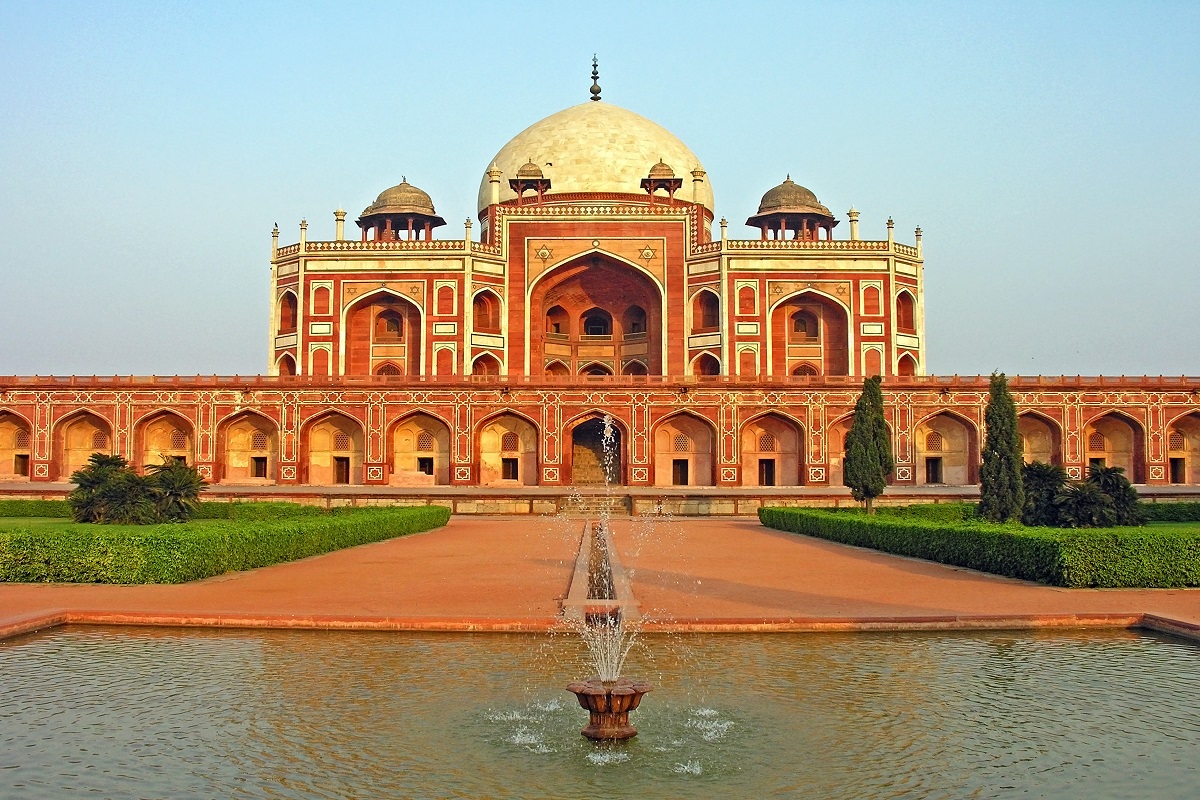The Humayun’s Tomb is a mausoleum constructed in the memory of the Mughal emperor Humayun. It happens to be the first garden tomb of the Indian subcontinent and is located in Nizamuddin East in Delhi India. It is close to the Citadel which is also known as the Old Fort or the Purana Qila. The Humayun’s Tomb is the first structure that has made use of a grand scale of red sandstone.
In the year 1993 this monument was declared as a UNESCO World Heritage site and since then has undergone several restoration works. The Humayun’s Tomb is the first specimen of Grand Mughal architecture which later experienced its glorious pinnacle with the construction of the magnificent Taj Mahal.
The Humayun’s Tomb was constructed across a lavish sprawling area of 27 hectares and includes magnificent 16th century Mughal era garden tombs of Isa Khan, Neela Gumbad, Afsar wala, Bu Halima and Babar’s tomb.
Humayun Tomb Built By
The Tomb was constructed under the orders of Humayun’s first wife and Chief Consort Bega Begum. She was also known as Haji Begum. The construction of the tomb began in the year 1565 and was completed by 1572. Historical documents offers that the tomb cost about 1.5 million rupees back then. The entire amount was paid by the Begam herself. Contemporary records offers that Bega Begum was so grieved over the death of her husband, that she dedicated her entire life to the sole purpose of creation of this mausoleum. She got down to the job of constructing the most beautiful and magnificent mausoleum of the Empire till date and commenced the construction of the Tomb near the shores of river Yamuna in Delhi.
According to the records of any Ain-i-Akbari, a detailed document of Akbar’s reign written in 16th century Bega Begam herself supervised the work of the tomb after returning from the visit of holy Mecca.
Humayun Tomb Timings
The Humayun’s tomb is one of the most popular tourist attractions in Delhi. Every year it attracts millions of visitors and tourists from not only the various parts of India but the world as a whole. The mausoleum is open all round the week from Monday to Sunday for the visitor. It is open from 8 a.m. in the morning to 6:00 p.m. in the evening.
If you wish to explore all the architecture details of the interiors of the tomb and experience the grandeur of the lavish Mughal gardens it is advisable to visit the Tomb during the daylight hours. This is the best time when you can witness its grandeur full scale.
During the day you can take mesmerizing pictures of the red sandstone construction against the deep blue sky. It is one of the most renowned paradises for photography lovers.
Humayun Tomb Information
The Humayun’s Tomb was although then constructed to commemorate the Tomb of Emperor Humayun, the construction also shelters the graves of Empress Bega Begum, Dara shikoh who was the great great grandson of Humayun, Hamida Begum along with other important Mughal like Jahandar Shah, Rafi Ul-Darjat, Farooqsiyar, Alamgir II etc. The tomb along with the beautiful Persian gardens or the Charbagh is a true specimen of Mughal architecture in the Indian subcontinent. Nothing like this was ever seen earlier in the Indian history.
It can be said that the Humayun’s tomb happened to be the very first specimen of the grand scale Mughal architecture which later found a number of other expression through the various construction completed by the Mughal emperors. The Humayun tomb was nothing like the mausoleum created in the memory of his father Mughal emperor Babur called the Baghe Babar. The latter happened to be much simpler in its design and scale.
Both Persian and Indian craftsman had worked to build the tomb and also the garden surrounding it. It is one of the grandest constructions ever to be seen by the Islamic world.
Humayun Tomb Location & How to Reach
Humayun’s tomb is located in Delhi. To reach the tomb you need to come down to Delhi first. This is a highly simple prospect since the national capital – Delhi is well connected to all other parts of the nation.
You can come down to Delhi either through flights or through the railway.
The nearest airport from Humayun’s tomb is Indira Gandhi International Airport which is at a distance of 15 km from the tomb. Once you are in the airport you can easily hire a public transport like a taxi or a cab and can reach the tomb in no time.
The Hazrat Nizamuddin railway station is the closest railway station from Humayun’s tomb and is just 2.5 kilometres away. Once you are in this railway station you can once again easily hire a private cab and can head for the destination. The Dargah Hazrat Nizamuddin bus stand is just 800 meters away from humayuns tomb. Once you are in this bus stand you can even walk down the distance. The Jor Bagh Metro station is the nearest metro station from Humayun’s Tomb. You can easily hire an auto or a taxi from this metro station to reach Humayun’s tomb in no time.
Humayun Tomb Ticket Price:
You need to pay a very minimal entry fee to enter the Humayun’s tomb. The Indian tourists and citizens of SAARC Nations must pay Rs. 35 as their entry fee. Other foreign tourists must pay Rs. 550 as their entry fee. Children up to the age of 15 years can visit the mausoleum for free. If you are planning to carry a camera inside the monument you will have to pay a fee of Rs. 25.
Humayun Tomb Architecture & Important Structures
The mausoleum stands on a wide terraced height platform which two very deeply vaulted cells on either side. The plan follows an irregular octagon pattern with four side and chamfered edges. There is a double dome 42.5 meter high with pillared kiosks of marble flanked on either side. The domes of the central chatris are decorated with glazed ceramic tile.
In the interior there is a huge octagonal chamber that has vaulted roof compartments. These are interconnected by a network of corridors and galleries. This plan with octagon shape is repeated on the second story as well. The structure is made out of stone clad in red sandstone and black and white inlaid marble borders.
The Humayun Garden to be also referred to as the dormitory of the Mughals because the construction has more than 150 tombs of the members of the Mughal family. The tomb is located at very nearby vicinity from the 14th century Sufi saint Hazrat Nizamuddin Auliya’s Shrine. In fact it is this close proximity from the shrine of Hazrat Nizamuddin Auliya which encouraged Bega Begum to select the location for the mausoleum.
During those days it was considered to be highly auspicious to be buried near a saint’s grave. The setting and the planning of the tomb was done on the lines which were defined as Paradise in the Holy Quran. The architectural pattern and design which was followed in the monument later became the dictum of Mughal construction in India.
Best time to visit humayun’s tomb
Delhi is reputed for sweltering heat. If you are an outsider and the tourists from a different place it is always best to avoid the Delhi summer. Once again if you wish to explore the Humayun’s Garden tomb in its minutest details you will have to remain out in the open and without air conditioning for quite some time. You need at least two to three hours to explore the entire Tomb and other monuments in the adjoining area. This is the main reason why you should visit the Tomb during the autumn winter and spring seasons. The months from November to March are the ideal months when you should visit the Humayun’s Tomb. The weather is highly compatible and you can remain out doors for a long time checking out all the aspects of the construction.
History of humayun’s tomb
Humayun’s Tomb is a very important point in the line of Mughal architecture. As mention in the earlier part of the discussion it was with this Garden tomb that the palatial and extravagant Mughal architecture came into existence. The mausoleums which were created before the Humayun’s tomb namely Berber’s tomb was much simpler in their designs, scale and carving.
The overall appearance was much different and much plainer. It was with the Humayun’s Tomb that dome shaped palatial mausoleums with more than one storey, use of red sandstone and gained further importance with the advancement of the Mughal Sultanate. The zenith of such architecture was obtained in the construction of Taj Mahal- another mausoleum created by Shah Jahan in the loving memory of his wife Mumtaz Mahal. If Taj Mahal is considered to be the peak of Mughal architectural extravagance, Humayun’s tomb can be considered to be the beginning of it all.
Attractions nearby humayun’s tomb
Delhi does not have a dearth of tourist attractions in the nearby vicinity. You can visit other places like the Deli Fort, Qutub Minar, Lotus Temple, Nizam Uddin Auliya shrine, Hazrat Nizamuddin Dargah, Sunder nursery, Swaminarayan Akshardham, Abdul Nabi mosque, the Sai Baba temple, the National Zoological Park of Delhi, etc.







